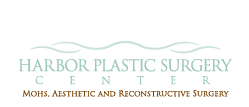Plastic Micrographic Surgery
(Mohs Plus)
Dr. Justin Piasecki is a uniquely trained member of the Mohs College, who is also Board-certified in plastic surgery and in facial plastic surgery. His combination of skills offers the high cure rate of Mohs surgery with the optimum cosmetic result of facial plastic surgery and general plastic surgery, for the most convenient, cost-effective skin cancer treatment available.
Plastic micrographic surgery is Mohs surgery with cosmetic reconstruction using both functional and cosmetic surgery principles, performed by a trained Mohs surgeon who is also Board-certified in plastic surgery and facial plastic surgery. This process begins with a surgical evaluation. Dr. Piasecki and the patient together decide which treatment method is the best approach for the patient’s particular skin cancer. Although plastic micrographic surgery and Mohs surgery offer the highest cure rate with the most tissue preservation, surgery is not always the best approach for every patient. One of the benefits of Plastic Micrographic Surgery is that the plastic surgeon that will repair the defect evaluates the patient prior to any tissue removal; only patients who are candidates for reconstruction will undergo Mohs surgery. Other possible treatments for skin cancer include: ED & C (scraping and burning), liquid nitrogen, radiation or simple excision with wide margins. Dr. Piasecki personally performs all treatment options based on indications and patient needs; patients needing radiation are referred to another Skin Cancer Center provider.
Mohs surgery is a unique procedure for skin tumor removal developed more than 50 years ago by Frederic Mohs, MD, a general surgeon at the University of Wisconsin. The Mohs technique has been refined and advanced since then, and now offers the highest cure rate (over 99%) for certain types of cancers while reducing the amount of tissue removed in the process.
During Mohs surgery, pieces of tissue are removed until the cancer is gone and the margins are clear. Following Mohs, for large defects and those in cosmetically sensitive areas, Dr. Piasecki uses plastic surgery techniques in his own ambulatory surgery center, to reconstruct the defect rather than referring the patient to another plastic surgeon for the reconstruction.
For complex cancers and those in cosmetically sensitive areas, plastic micrographic surgery is a more convenient process for the patient and lowers costs for the patient and the insurance company, while providing the same high cure rate and tissue preservation associated with traditional Mohs surgery.
Plastic Micrographic Surgery Specifics
The Surgery
Under local anesthesia, Dr. Piasecki removes skin tumors one layer at a time, and the entire edge – or margin – of that removed layer of tissue is immediately examined under a microscope. The surgeon then removes additional tissue only in the area(s) where the margins have tested positive as cancerous. Those tissue sections are examined under a microscope and the process is repeated until all margins are clear of cancer. These tumors can be thought of as roots of a tree, growing and extending beyond their direct center, not visible to the naked eye. While most cases are cleared in one to three stages, larger or recurrent tumors often require multiple stages of removal and testing. Once the site is cancer free, the open wounds that can be closed without reconstructive surgery are closed up immediately in our clinic. If reconstructive surgery is necessary, it will be performed in our ambulatory surgery center following Mohs surgery. The ambulatory surgery facility was built to the strictest AAAHC and Medicare standards and provides the safest environment for reconstructive surgery.
Reconstruction
Dr. Piasecki has extensive training in reconstructive and cosmetic procedures. He closes wounds as discretely as possible with stitches, grafts or flaps and involves the patient from the beginning in evaluating their reconstructive options. Careful consideration of the functional as well as aesthetic requirements of the face are essential, and Dr. Piasecki helps patients weigh the desired cosmetic result with the recovery process. Mohs surgery preserves the maximum amount of normal skin compared to other techniques, resulting in smaller defects with the most desired long-term appearance outcome.
Patient Preparation for Surgery
Patients may continue taking their usual medications, even on the day of surgery, unless otherwise directed by a physician. Please inform Dr. Piasecki if you are taking any blood-thinning medications such as Warfarin, Plavix, aspirin, ibuprofen, Vitamin E or others, as blood thinners can lead to increased bleeding, swelling and bruising following surgery. Prior to surgery, patients are instructed to get a good night's rest and can eat regular meals. We provide coffee, tea, juice, water and granola bars in our waiting area. There is also a refrigerator and microwave available for personal use. For other food and drink options, patients can visit the cafeteria in St. Anthony’s Hospital that is connected to our surgery center. Books, magazines or a laptop computer can help pass the time during down periods.
If you require reconstructive surgery, your surgery will occur in our surgery center, and not a hospital. Our ambulatory surgery center follows strict outpatient surgery center regulations, but feels more comfortable for most patients than a hospital operating room. Once we are ready for your reconstruction, you will be taken to our patient waiting room to go through the treatment plan, sign consents and change into an operating room gown. It is suggested that you come wearing comfortable clothing and have an extra layer of clothes on hand for added warmth. A button-up or zippered shirt that can be removed without going over the head is preferred. You will be assisted in changing back into your street clothes after surgery is complete. We will discuss patient transportation home with you prior to your appointment.
The Process
Treatment begins with a private consultation with Dr. Piasecki. Dr. Piasecki reviews the patient's medical history and discusses all viable options for skin cancer treatment. He then works with the patient to determine the best course of treatment. The informed consent form is then completed to ensure that Dr. Piasecki and the patient have a mutual understanding of the surgical process and treatment is scheduled. Click here for a copy of the Mohs surgery consent form to read and sign prior to surgery.
Local anesthesia is administered to the affected area. Once the anesthesia has taken effect, the first level of tissue is removed. The patient is then taken to the waiting room to relax while the tissue is frozen and processed. This frozen tissue section processing and microscopic examination of the lesion requires 45 minutes to an hour. During this time the patient is free to relax in the Mohs waiting room, a quiet, peaceful environment in which friends and family are welcome, or may wait in their private room. Light snacks and beverages are available. Patients may choose to pass the time reading or watching television while waiting for results. If any of the cancer remains, the patient goes back to their procedure room and another layer of tissue is removed in the area where the margin was positive. The patient then may relax while the tissue is examined. This process is repeated until the margins are clear of cancer.
If the wound can be closed without reconstructive surgery, Dr. Piasecki will close it in the clinic and the patient may go home.
If reconstructive surgery is required, Dr. Piasecki will perform reconstructive surgery in the ambulatory surgery center using the plastic surgery technique that he and the patient have agreed will satisfy the patient’s needs and provide the best aesthetic result. Patients are scheduled in groups of 2 or 3. Due to regulations, all patients from the clinic must be cleared before we open the operating room for reconstructions. Therefore, there may be a delay prior to beginning reconstructive surgery. If this happens, patients can either wait in our waiting room or may leave the center and we'll call them with a time to return.
The tumor removal process (Mohs surgery) typically takes 1-3 hours. Patients requiring medication for anxiousness will not be released without a driver to transport them. If reconstructive surgery is required, it generally lasts 30 – 90 minutes. We ask that all patients have a driver to transport them after this procedure. On occassion complex cases can require more time, many stages, and/or delayed reconstructive repairs. In such cases, Dr. Piasecki will discuss these issues with the patient in advance, addressing any questions or concerns to determine the best overall approach to treatment.
Expected Recovery Process for Surgery
Most patients describe the pain following surgery as “throbbing” or “like a deep bruise”, but it is not typically sharp in nature. Surgery on the forehead or scalp may trigger headaches on the first night or for a few days of recovery. Patients should take it easy for a week to ten days following surgery, with no heavy lifting (greater than a gallon of milk) or strenuous exercise.
Depending on the size and location of the wound, “oozing” of fluid from the wound will occur for the first week or so following surgery. Bruising, drainage of fluid and swelling will be at their peak at 72 hours following surgery, and occasionally this bleeding becomes heavier; if this happens, patients are asked to apply continuous pressure for 20 minutes. If the bleeding persists, call Dr. Piasecki immediately. You will be directed to either come to the clinic or visit a local emergency room.
Mohs surgery is a minimally invasive procedure and complications are rare, but they can happen. Dr. Piasecki will discuss these with you the morning of surgery.
If you have any concerns following surgery, we ask that you call Dr. Piasecki during business hours at 253-858-5040 or after hours at 253-509-4438.
Medications During and After Surgery
A patient may be given antibiotics on the day of surgery and for a short period post-operatively. In addition, a mild sedative (lorazepam) may be given if the patient feels anxious or the tumor is complex and requires prolonged removal and reconstruction time. Over-the-counter and/or prescription pain medications may also be prescribed to minimize discomfort.





